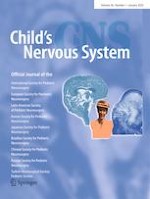Erschienen in:

31.07.2019 | Case Report
Peripheral facial nerve palsy following ventriculoperitoneal shunting in an infant
verfasst von:
Mehdi Golpayegani, Zohreh Habibi, Mahtab Rabbani Anari, Farideh Nejat
Erschienen in:
Child's Nervous System
|
Ausgabe 1/2020
Einloggen, um Zugang zu erhalten
Abstract
Peripheral facial palsy due to injury to the extracranial segment of facial nerve following ventriculoperitoneal (VP) shunting has been reported in a few adults or adolescents. Herein, we present a case of iatrogenic facial nerve palsy secondary to VP shunt insertion in a 20-month infant. To the best of our knowledge, this is the first infantile case to be ever reported in the literature. Regarding the postnatal development of the mastoid and styloid process, the underdeveloped bony structures may render extracranial part of the facial nerve more vulnerable to blunt trauma. The lesson can be learned from this case is that tunneling procedure should be done with caution in pediatric age group especially around the mastoid area.